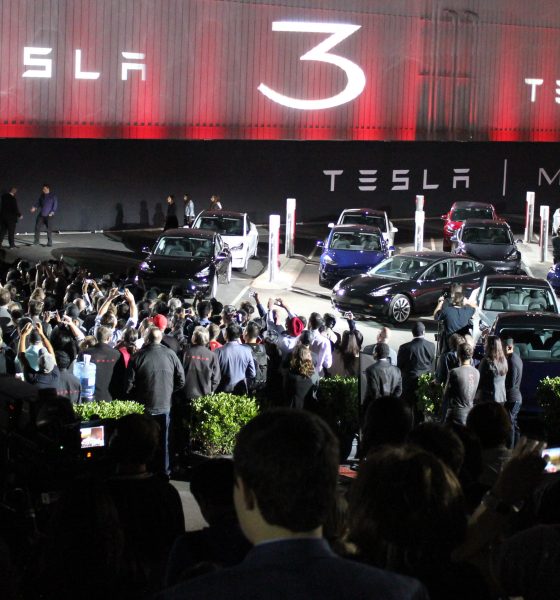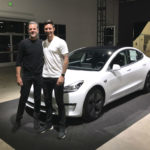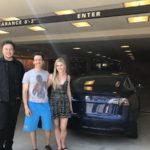

Investor's Corner
Elon Musk rallies Tesla community to help with Q3 2018 deliveries
It is difficult to deny that Tesla is a company with a dedicated following. Over the years, its electric cars and energy storage products, together with Elon Musk’s rockstar CEO status, allowed Tesla to become one of the most recognizable brands in the automotive industry. This has also allowed the company to garner a strong consumer base that is willing to pay it forward.
Tesla is facing what Elon Musk dubs as “delivery logistics hell” due to the sheer number of customer deliveries that need to be done before the end of Q3 2018. Tesla has stepped up to the challenge, reportedly conducting deliveries in its centers until 10 p.m. and adopting processes such as a 5-Minute Sign & Drive system to expedite the handover process. As the end of the third quarter nears, though, it has become evident that the company could use a helping hand.
A suggestion for a solution to help Tesla’s Q3 deliveries was suggested by IGN journalist and Ride the Lightning podcast host Ryan McAffrey on Twitter, who noted that he and a lot of Tesla owners would be willing to volunteer their time to help out with deliveries. While Tesla owners cannot help with the paperwork, they could help orient newcomers about the functions and features of their new electric car. Elon Musk loved the idea, stating that any help would be appreciated.
Wow, thanks for offering to help! The coming week is incredibly intense. If any current Tesla owners who’d like to help educate new owners could head to Tesla delivery centers during midday on Sat/Sun & morning/evening on weekdays, that would be super appreciated!
— Elon Musk (@elonmusk) September 22, 2018
All across the social media sphere, the Tesla community immediately came alive. In Twitter alone, several owners volunteered to help out, from those who have driven the company’s vehicles since the days of the original Roadster, to those who have just received their Model 3 recently. Influencers who command a strong following in social media, as well as members of dedicated Tesla clubs, announced that they would pitch in as well. Some even noted that they would be bringing food and drinks.
It is rare to see a car company command such a dedicated following, but considering Tesla’s place in the auto industry today, the strong brand loyalty exhibited by its consumer base is not very surprising. Over the years, Tesla has pretty much transformed itself into an entity that is more than a regular car company or an energy storage provider. In a way, Tesla has become a movement of sorts, a brand that symbolizes a few embers of optimism in a world that is growing more disillusioned by the day. It would be rather easy to criticize Elon Musk for being a leader that still shows a degree of naivette from time to time, but in the case of Tesla, his leadership is arguably one of the reasons why regular electric car owners are willing to spend their personal time to help out the company.
- Tesla Chief Designer recently made a Model 3 delivery very special. [Credit: Andre Mercier/Tesla Motors Club]
- Tesla Model 3 delivery to customers’ homes. [Credit: Devin Scott/Twitter]
Tesla CEO Elon Musk and Chief Designer Franz von Holzhausen conducting Model 3 deliveries.
While aggressive critics of Tesla would be quick to state that the company commands a “cult” following, it’s not like its customers’ loyalty is misplaced. In the electric car market alone, it is starting to become evident that Tesla, a young carmaker that has only been around for 15 years, holds a significant lead in the EV market. Toni Sacconaghi of Bernstein, an analyst who quite literally incited Elon Musk’s frustration in an earnings call, recently pointed out that contrary to a persistent bear thesis, there is “no actual flood of competition coming” for Tesla’s vehicles, even from established legacy carmakers.
Tesla’s strength and its strong consumer loyalty are reflected in the company’s Net Promoter Score (NPS), which stands as among the highest in the auto industry. Last year alone, Tesla earned a 97 in its NPS, the highest score among automakers currently active in the US. As noted by ConsumerGauge in its analysis of Tesla’s rating back in 2017, the company’s industry-leading NPS seems to be influenced by the company’s radical approach to vehicles and the car buying experience, as well as Elon Musk’s bold, hands-on approach to the company.

Investor's Corner
Tesla stock closes at all-time high on heels of Robotaxi progress

Tesla stock (NASDAQ: TSLA) closed at an all-time high on Tuesday, jumping over 3 percent during the day and finishing at $489.88.
The price beats the previous record close, which was $479.86.
Shares have had a crazy year, dipping more than 40 percent from the start of the year. The stock then started to recover once again around late April, when its price started to climb back up from the low $200 level.
This week, Tesla started to climb toward its highest levels ever, as it was revealed on Sunday that the company was testing driverless Robotaxis in Austin. The spike in value pushed the company’s valuation to $1.63 trillion.
Tesla Robotaxi goes driverless as Musk confirms Safety Monitor removal testing
It is the seventh-most valuable company on the market currently, trailing Nvidia, Apple, Alphabet (Google), Microsoft, Amazon, and Meta.
Shares closed up $14.57 today, up over 3 percent.
The stock has gone through a lot this year, as previously mentioned. Shares tumbled in Q1 due to CEO Elon Musk’s involvement with the Department of Government Efficiency (DOGE), which pulled his attention away from his companies and left a major overhang on their valuations.
However, things started to rebound halfway through the year, and as the government started to phase out the $7,500 tax credit, demand spiked as consumers tried to take advantage of it.
Q3 deliveries were the highest in company history, and Tesla responded to the loss of the tax credit with the launch of the Model 3 and Model Y Standard.
Additionally, analysts have announced high expectations this week for the company on Wall Street as Robotaxi continues to be the focus. With autonomy within Tesla’s sights, things are moving in the direction of Robotaxi being a major catalyst for growth on the Street in the coming year.
Elon Musk
Tesla needs to come through on this one Robotaxi metric, analyst says
“We think the key focus from here will be how fast Tesla can scale driverless operations (including if Tesla’s approach to software/hardware allows it to scale significantly faster than competitors, as the company has argued), and on profitability.”

Tesla needs to come through on this one Robotaxi metric, Mark Delaney of Goldman Sachs says.
Tesla is in the process of rolling out its Robotaxi platform to areas outside of Austin and the California Bay Area. It has plans to launch in five additional cities, including Houston, Dallas, Miami, Las Vegas, and Phoenix.
However, the company’s expansion is not what the focus needs to be, according to Delaney. It’s the speed of deployment.
The analyst said:
“We think the key focus from here will be how fast Tesla can scale driverless operations (including if Tesla’s approach to software/hardware allows it to scale significantly faster than competitors, as the company has argued), and on profitability.”
Profitability will come as the Robotaxi fleet expands. Making that money will be dependent on when Tesla can initiate rides in more areas, giving more customers access to the program.
There are some additional things that the company needs to make happen ahead of the major Robotaxi expansion, one of those things is launching driverless rides in Austin, the first city in which it launched the program.
This week, Tesla started testing driverless Robotaxi rides in Austin, as two different Model Y units were spotted with no occupants, a huge step in the company’s plans for the ride-sharing platform.
Tesla Robotaxi goes driverless as Musk confirms Safety Monitor removal testing
CEO Elon Musk has been hoping to remove Safety Monitors from Robotaxis in Austin for several months, first mentioning the plan to have them out by the end of 2025 in September. He confirmed on Sunday that Tesla had officially removed vehicle occupants and started testing truly unsupervised rides.
Although Safety Monitors in Austin have been sitting in the passenger’s seat, they have still had the ability to override things in case of an emergency. After all, the ultimate goal was safety and avoiding any accidents or injuries.
Goldman Sachs reiterated its ‘Neutral’ rating and its $400 price target. Delaney said, “Tesla is making progress with its autonomous technology,” and recent developments make it evident that this is true.
Investor's Corner
Tesla gets bold Robotaxi prediction from Wall Street firm
Last week, Andrew Percoco took over Tesla analysis for Morgan Stanley from Adam Jonas, who covered the stock for years. Percoco seems to be less optimistic and bullish on Tesla shares, while still being fair and balanced in his analysis.

Tesla (NASDAQ: TSLA) received a bold Robotaxi prediction from Morgan Stanley, which anticipates a dramatic increase in the size of the company’s autonomous ride-hailing suite in the coming years.
Last week, Andrew Percoco took over Tesla analysis for Morgan Stanley from Adam Jonas, who covered the stock for years. Percoco seems to be less optimistic and bullish on Tesla shares, while still being fair and balanced in his analysis.
Percoco dug into the Robotaxi fleet and its expansion in the coming years in his latest note, released on Tuesday. The firm expects Tesla to increase the Robotaxi fleet size to 1,000 vehicles in 2026. However, that’s small-scale compared to what they expect from Tesla in a decade.
Tesla expands Robotaxi app access once again, this time on a global scale
By 2035, Morgan Stanley believes there will be one million Robotaxis on the road across multiple cities, a major jump and a considerable fleet size. We assume this means the fleet of vehicles Tesla will operate internally, and not including passenger-owned vehicles that could be added through software updates.
He also listed three specific catalysts that investors should pay attention to, as these will represent the company being on track to achieve its Robotaxi dreams:
- Opening Robotaxi to the public without a Safety Monitor. Timing is unclear, but it appears that Tesla is getting closer by the day.
- Improvement in safety metrics without the Safety Monitor. Tesla’s ability to improve its safety metrics as it scales miles driven without the Safety Monitor is imperative as it looks to scale in new states and cities in 2026.
- Cybercab start of production, targeted for April 2026. Tesla’s Cybercab is a purpose-built vehicle (no steering wheel or pedals, only two seats) that is expected to be produced through its state-of-the-art unboxed manufacturing process, offering further cost reductions and thus accelerating adoption over time.
Robotaxi stands to be one of Tesla’s most significant revenue contributors, especially as the company plans to continue expanding its ride-hailing service across the world in the coming years.
Its current deployment strategy is controlled and conservative to avoid any drastic and potentially program-ruining incidents.
So far, the program, which is active in Austin and the California Bay Area, has been widely successful.










